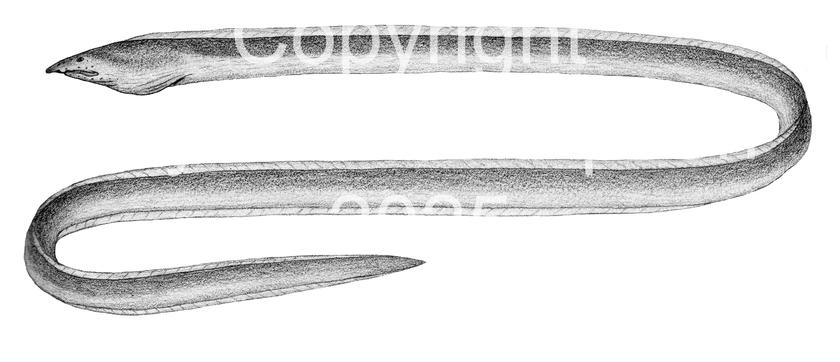
Common Name
Slantlip Eel
Year Described
Böhlke, 1955
Identification
Vertebrae: 138-155 (68-79 pre-anal)
Body elongate and cylindrical in cross-section. Trunk a little longer than tail (52-55% TL). Snout pointed laterally, flattened dorsally, and overhangs mouth. Underside of snout with no median groove. Eye small and close to snout tip. Anterior nostril a simple hole with undulating, non-raised edges on underside of snout. Posterior nostril opens in mouth. Lower jaw with a prominent grooved flange at base. Jaw teeth small and uniserial. Maxillary teeth 8-12. Dentary teeth 8-11. Four enlarged intermaxillary teeth at the front of the upper jaw. Vomerine teeth (single row of 5-8) are enlarged. Gill openings low on body and converging anteriorly. Gill pouch and body finely grooved. Dorsal fin origin well before gill openings, high in height anteriorly, and ending before tail tip. Anal fin present. Pectoral and caudal fins absent. Tail tip hard and pointed. Lateral line complete.
Color
Body bicolored dark brown and cream, sometimes with a sharp demarcation between them. Pores not lighter. Lateral line often pale on darker specimens. Fins cream colored.
Size
Maximum size to 45.6cm TL.
Habitat
Insular localities on calm sandy bottoms and shallow seagrass beds from 0-12m.
Range
Florida (both coasts) to S. Brazil, including the Gulf of Mexico and Caribbean islands. Mostly encountered at island localities.
References
Böhlke, J. E. 1955. A new genus and species of ophichthid eels from the Bahamas. Notulae Naturae (Philadelphia) No. 282: 1-7.
Carvalho-Filho, A. 2023. Fishes of the Brazilian coast. Literare Books International, São Paulo: 1-424.
McEachran, J. D. & J. D. Fechhelm. 1998. Fishes of the Gulf of Mexico. Volume 1: Myxiniformes to Gasterosteiformes. Univ. of Texas Press, Austin. 1-1112.
Other Notes
Further study is needed on bicolored material with 150-155 vertebrae to see if they are a separate species from the more unicolorous material with 140-148 vertebrae.